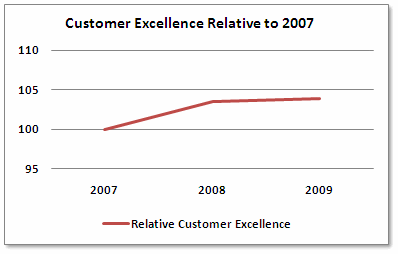As part of an MBA Global Study trip back in 1989, I found myself in Japan in the boardroom of Fujitsu Corporation with the vice-chairman of the board and other senior executives. Prior to the meeting, I had pored over Fujitsu’s financial reports, and the results were puzzling — revenue growth was high, but returns such as net income ratio and net operating margins were very low.
When the vice-chairman finished his presentation, I asked what accounted for Fujitsu’s low margins and low stockholder equity. I also pointed to high employee compensation costs and told him that if Fujitsu were a U.S. company, there was a good chance it would have disappeared via a LBO by now.
His response was simple, but fascinating. The Fujitsu philosophy is simple: employees first, customers second, community third, and stockholders last. It works for them. Today, Fujitsu is Japan’s largest provider of IT services and the fourth largest in the world.
As if to drive the point home, I was recently struck by the title of a just-published book, “Employees First, Customers Second: Turning Conventional Management Upside Down,” by Vineet Nayar, CEO of HCL technologies, a large, successful Indian information system outsourcing company.
Does the concept of employees first make sense? Today, the primary mandate for most CEOs continues to be maximizing shareholder return, although in recent years, a concept closely related to the employees first philosophy – employee engagement – has become an integral part of successful organizations’ growth strategies.
Defining Employee Engagement
The definition of employee engagement has been a source of debate for nearly a decade among academics and practitioners. Today, it refers to the emotional, intellectual, and behavioral commitment employees make to their work and organizations. There is also general consensus that engaged employees have a positive impact on organizations; therefore it is being embraced as a key human capital metric.
Do engaged employees drive financial performance as measured by revenue, net income, and ultimately, stock price? Indeed, there is evidence that engaged employees have a positive impact on customer service and loyalty, as well as retention, productivity, and individual, team, and organizational performance.
Many consulting companies that conduct employee engagement studies have claimed direct and significant correlation between financial metrics and employee engagement. However, their methodologies for measuring this are often faulty or weak on fundamentals, as they do not establish a causative relationship.
While I believe that engaged employees do contribute to financial performance, the relationship can be better measured by specific benchmarks such as customer satisfaction. Accurate studies of relationships such as employee engagement and customer satisfaction are rare for two primary reasons:
- They require measurements over multiple years, with little-to-no change in the measurement techniques over that time period. While many companies aspire to achieve this, in reality, changing priorities, limited budgets, and turnover often get in the way.
- They require measurements in two very different areas of the business to be happening simultaneously and to share results across business units. Too often, these studies are not happening in parallel, or if they are, the data does not flow across business unit boundaries.
Where there are opportunities to conduct multi-disciplinary studies, the results are fascinating. In parallel Employee Engagement and Customer Satisfaction studies that we have been conducting at a global professional organization over many years, the results demonstrate a significant positive correlation between the employee engagement metric and customer satisfaction. In terms of performance metrics, this organization has seen tremendous success, far outperforming its peer group over the last three years.
Figure 1 (Employee Engagement Relative to 2007) shows relative change from 2007 (indexed at 100) to 2009 in employee engagement index and Figure 2 (Customer Excellence Relative to 2007) shows relative change in customer excellence index (a measure of customer satisfaction). The engagement index is based on responses to a set of 16 items, a few of which are shown above (see Selected Employee Engagement Questions). The correlation between employee engagement and customer excellence metrics is 0.98, a perfect correlation.
So why does this fast-growing professional organization demonstrate an undeniably strong relationship between employee engagement and positive customer satisfaction year after year? Because the organization is committed to conducting accurate studies, acting on the outcomes and doing it right. More organizations should take this approach. Here are some of the best practices to help ensure success:
- Don’t wait a whole year to measure customer satisfaction. Measuring customer or member satisfaction quarterly gives the organization deeper, more meaningful insight into the successes and areas for improvement and the ability to implement change and then assess in a future survey.
- Go beyond the annual survey for culture and employee engagement. Intermediate pulse studies applied to 50 percent of the employee base – every four months or so – often reveal new issues, potential trends and initiatives that
 are and are not working (e.g., a new senior manager doesn’t fit with the overall culture of the organization) and give the organization the ability to quickly affect change.
are and are not working (e.g., a new senior manager doesn’t fit with the overall culture of the organization) and give the organization the ability to quickly affect change. - Adapt the survey to your strategic needs. Organizations using cookie cutter surveys are wasting their resources, time, and money. Highly effective and accurate survey studies should be adapted to an organization’s culture, values, and overall philosophy. The study also needs to be durable from year to year, but regularly reviewed to ensure it remains aligned with the company’s culture.
